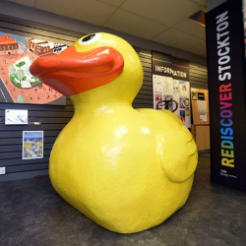Our weekly round-up of outlandish and interesting information collected from the corners of the charity sector.
A duck’s tale
Connoisseurs of local newspaper stories will agree with Diary that, as introductions go, the above is an excellent example of the breed. "Why, Diary?" this column can hear you ask, though. "Why are you bringing this to our attention?"
Because, the locals have called the investment of £2,500 of their hard-earned on a giant duck "quackers," that's why. And because the council of Stockton-on-Tees has defended the splurge by saying, and Diary quotes, “the six-foot duck is used to promote the mayor’s annual duck race and will help raise thousands for charity”.
Bob Cook – the council leader – went even further, saying the statue is “not only fun” but a “family attraction in the high street” and that the council “also expect it to help raise many thousands of pounds for charities in the coming years as we will be making it available for corporate sponsorship”.
Where to start with this? Can life truly be so bleak, so tragic in this part of the British Isles that the greatest moment of this town’s existence comes every November, when a bunch of (presumably) rubber ducks are floated down the River Tees?
Also, what corporation would be willing to have its name and branding associated with such a bizarre ritual? And how much money can this raise? And for what charity? And why do they race ducks in the first place? When did this start? What purpose does any of this serve?
Enough. Diary can’t take anymore. Let’s just forget it ever happened. Water off a duck’s back…
Tintagel’s rock of witchcraft and wizardry
Diary can remember a time where successfully lampooning the doings of the charity sector was a hand-to-mouth existence. Sure, there were times of great boom – Brooks Newmark springs to mind – but there were also barren spells, times of famine, stretches of arid material stretching as far as the mind’s eye could see.
Then, mercifully, like an oasis in the desert, came the formation of English Heritage’s charitable arm and it’s been a veritable satirical buffet ever since. Since the turn of the year alone, English Heritage has used charitable funds to ‘live’ tweet a 900 and more-year-old battle and offended a druid so much that he stormed out of a public meeting.
Good times.
Actually, while we’re on the subject of druids and the distant, mythical origins of the ancient Britons, let’s talk Tintagel. The tiny, Cornish coastal town whose only claim to fame rests on its castle and the ‘fact’ that King Arthur (who may have, but probably didn’t, exist) was possibly born there (almost, probably, definitely, maybe not).
In its latest wheeze, English Heritage commissioned a local artist to carve the face of Merlin, the legendary wizard of the Arthurian legend, into the living rock of the Cornish coast. While the work was commissioned in the right place, you’d have thought – right by ‘Merlin’s Cave’ – it has still angered Cornwall councillor Bert Briscoe, who has written to the charity accusing it of the ‘Disneyfication’ of the area.
“If we start carving comic book characters into the geology, where do we stop?” he asks. A very good question, Councillor Briscoe. Where indeed? A Wonder Woman by Woolacombe Bay? Superman on the Seven Sisters? A 50-foot-high Deadpool hewn into the cliffs of Dover? The last idea would, at the very least, confuse the French.
“This is Cornwall, not Disneyland,” says Mr Briscoe, and this column can’t help but agree – sure, there are plenty of fat people in Cornwall, but none of them is likely to be wearing Mickey Mouse ears, a garish Hawaiian shirt and a bum-bag in the dying days of March.
Diary loves you English Heritage, never change!









